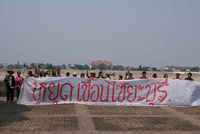LAOS: Villagers brace for relocation as dam project moves forward
In June, a Lao official came to Pakmon and said any families who lived below 275m - the projected height of the dam's reservoir - would be forced to relocate. According to the US environmental group International Rivers, more than 2,100 people will be forcibly resettled and 200,000 people will be affected.
Ting does not know exactly how the proposed Xayaburi hydropower dam will change his life, but he knows he will be forced to leave his village if it goes ahead.
"I don't have any power over this decision," said Ting, 50, who like other Lao villagers, goes by only one name. He earns a living ferrying passengers across the Mekong River in a motorized skiff and lives in Pakmon, a village of 150 families just 30km upstream from the proposed US$3.8 billion dam in the impoverished Xayaburi Province.
In June, a Lao official came to Pakmon and said any families who lived below 275m - the projected height of the dam's reservoir - would be forced to relocate.
Now Ting and other villagers, many of whom earn no more than US$500 per year, are anxious to see if the dam will be built, and how their main livelihoods - fishing and farming - will be affected.
According to the US environmental group International Rivers, more than 2,100 people will be forcibly resettled and 200,000 people will be affected.
"Given the Laos government's legacy of poor planning and uncompensated losses, the communities that will be forcibly resettled by the dam are likely to suffer greatly," Ame Trandem, a spokesperson for International Rivers, told IRIN.
"Unchartered waters"
Plans to dam the lower stretch of the Mekong, the world's 12th-largest river, have put Laos on a collision course with its neighbours and environmentalists, who fear livelihoods, fish species and farmland could be destroyed, undermining the food security of thousands.
China, which borders Laos, already operates four dams on the upper stretch of the river.
In May, Khempheng Pholsena, chairwoman of the Laos National Mekong Committee, told reporters in Hanoi, Vietnam, that the Xayaburi dam would be "socially and environmentally sustainable".
This followed critical statements by Thai, Cambodian and Vietnamese diplomats about the Xayaburi proposal in April, calling for more studies of the dam's trans-boundary impacts.
Then in an 8 June letter leaked to the media and addressed to Xayaburi Power Ltd, a subsidiary of Ch Karnchang, the Thai developer, the Lao Ministry of Energy and Mines claimed to have "completed" its obligation for prior consultation regarding the dam proposal under the 1995 Mekong Agreement, which established a non-binding process for reviewing mainstream dam proposals by any of the four lower Mekong River Countries (MRC): Laos, Thailand, Cambodia and Vietnam.
Two weeks later, a group of MRC donors asked Laos to clarify its position, but has yet to receive a response.
As of late May, the project appeared to be dead, presumably because Laos did not want to "lose face" by breaking with Vietnam, a close political ally that has expressed strong opposition to the proposed dam, said Ian Baird, a Laos expert at the University of Wisconsin-Madison. However, the leaked letter suggests a different scenario, he maintains.
"It is hard to believe that the Lao government is going ahead with this [dam] despite strong opposition in the region, including from the Vietnam government, but that would appear to be the case," he said.
"We are in unchartered waters on this one," Baird added.
Livelihoods in the balance
Laos claims the Mekong dams would lift its people out of poverty and help it achieve its stated goal of escaping "least developed country" status by 2020.
But an independent report warned in October 2010 that the proposed dams would have "permanent and irreversible" effects on downstream communities and ecosystems.
US Secretary of State Hillary Rodham Clinton echoed those concerns on 22 July, warning at a conference in Bali that if one Mekong country built a dam, neighbouring countries would feel the environmental and social consequences.
Ch Karnchang has promised some villagers near the dam it will build them homes, a school and a hospital, and give them $250 in one-time loans for purchasing livestock, according to villagers.
Yet even if such benefits materialize, says David Blake, a UK-based Laos aquaculture expert, who has worked in Xayaburi Province, the villagers will have trouble finding places to grow lowland rice, a staple crop.
Villagers may be forced to give up farming and rely on handouts, Blake said, or else migrate to cities and "join the swelling ranks of urban, landless poor".



